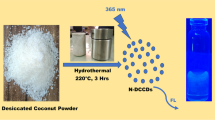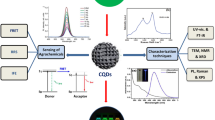Abstract
A fluorometric assay was developed for the determination of copper(II) ion based on its quenching effect on the green fluorescent probe of SiO2-anchored CdS nanocrystals (SiO2/CdS NCs). The fluorescent probe was prepared by a surface ion-directing strategy for homogeneous precipitation of CdS NCs onto the carboxyl-capped SiO2 core surfaces. In comparison to CdS NCs, the SiO2/CdS NCs has strong fluorescence emission and good photostability. Moreover, SiO2/CdS NCs show higher fluorescence selectivity for copper(II) ions than for other common metal ions because copper(II) ions have a strong fluorescence quenching effect on SiO2/CdS NCs. At excitation/emission wavelengths of 300/516 nm, the resulting fluorescent probe shows wide linear ranges from 0.01 to 2 μM with a detection limit of 6.3 nM for copper(II) ions. The method has been applied to the determination of trace copper(II) ions in tea infusions with satisfactory results.

Graphical abstract





Similar content being viewed by others
References
Bekhradnia A, Ghanbarimasir Z (2016) A novel sensitive fluorescent coumarin-based chemosensor for detection of copper ion. Pharm Anal Acta 7:461–464
Liu S, Wang Y, Han J (2017) Fluorescent chemosensors for copper(II) ion: structure, mechanism and application. J Photochem Photobiol C 32:78–103
Kumawat LK, Mergu N, Singh AK, Gupta VK (2015) A novel optical sensor for copper ions based on phthalocyanine tetrasulfonic acid. Sensors Actuators B 212:389–394
Su Y, Lan G, Chen W, Chang H (2010) Detection of copper ions through recovery of the fluorescence of DNA-templated copper/silver nanoclusters in the presence of mercaptopropionic acid. Anal Chem 82:8566–8572
Chan MS, Huang SD (2000) Direct determination of cadmium and copper in seawater using a transversely heated graphite furnace atomic absorption spectrometer with zeeman-effect background corrector. Talanta 51:373–380
Wu J, Boyle EA (1997) Low blank preconcentration technique for the determination of lead, copper, and cadmium in small-volume seawater samples by isotope dilution ICPMS. Anal Chem 69:2464–2470
Shah A, Sultan S, Shah AH, Nayab S, Khan GS, Hussain H (2017) An electrochemical sensing platform for the trace level detection of copper. J Electrochem Soc 164:B184–B188
Wei H, Pan D, Hu X, Liu M, Han H, Shen D (2018) Voltammetric determination of copper in seawater at a glassy carbon disk electrode modified with Au@MnO2 core-shell microspheres. Microchim Acta 185:258–266
Shao H, Wen X, Ding Y, Hong X, Zhao H (2019) Colorimetric determination of copper (II) by using branched-polyethylenimine droplet evaporation on a superhydrophilic-superhydrophobic micropatterned surface. Microchim Acta 186(11):701–710
Krämer R (1998) Fluorescent chemosensors for Cu2+ ions: fast, selective, and highly sensitive. Angew Chem Int Ed 37:772–773
Zhang S, Yu T, Sun M, Yu H, Zhang Z, Wang S, Jiang H (2014) Highly sensitive and selective fluorescence detection of copper(II) ion based on multi-ligand metal chelation. Talanta 126:185–190
Kumar M, Kumar N, Bhalla V, Sharma PR, Kaur T (2012) Highly selective fluorescence turn-on chemodosimeter based on rhodamine for nanomolar detection of copper ions. Org Lett 14:406–409
Xu G, Wang J, Si G, Wang M, Xue X, Wu B, Zhou S (2016) A novel highly selective chemosensor based on curcumin for detection of Cu2+ and its application for bioimaging. Sensors Actuators B Chem 230:684–689
Berlina AN, Zherdev AV, Dzantiev BB (2019) Progress in rapid optical assays for heavy metal ions based on the use of nanoparticles and receptor molecules. Microchim Acta 186(3):172–210
Zhao L, Li H, Xu Y, Liu H, Zhou T, Huang N, Li Y, Ding L (2018) Selective detection of copper ion in complex real samples based on nitrogen-doped carbon quantum dots. Anal Bioanal Chem 410:4301–4309
Guo Y, Zhang L, Zhang S, Yang Y, Chen X, Zhang M (2015) Fluorescent carbon nanoparticles for the fluorescent detection of metal ions. Biosens Bioelectron 63:61–71
Yuan C, Zhang K, Zhang Z, Wang S (2012) Highly selective and sensitive detection of mercuric ion based on a visual fluorescence method. Anal Chem 84:9792–9801
Zou WS, Deng MY, Wang YQ, Zhao X, Li WH, Huang XH (2019) Alginate capped and manganese doped ZnS quantum dots as a phosphorescent probe for time-resolved detection of copper(II). Microchim Acta 186(1):41–49
Sang F, Zhang X, Shen F (2019) Fluorescent methionine-capped gold nanoclusters for ultra-sensitive determination of copper(II) and cobalt(II), and their use in a test strip. Microchim Acta 186(6):373–381
Chen B, Zhong P (2005) A new determining method of copper(II) ions at ng ml−1 levels based on quenching of the water-soluble nanocrystals fluorescence. Anal Bioanal Chem 381:986–992
Chen Y, Rosenzweig Z (2002) Luminescent CdS quantum dots as selective ion probes. Anal Chem 74:5132–5138
Wang J, Yu J, Wang X, Wang L, Li B, Shen D, Kang Q, Chen L (2018) Functional ZnS:Mn(II) quantum dot modified with L-cysteine and 6-mercaptonicotinic acid as a fluorometric probe for copper (II). Microchim Acta 185:420–432
Zhang YH, Zhang HS, Guo XF, Wang H (2008) L-Cysteine-coated CdSe/CdS core-shell quantum dots as selective fluorescence probe for copper (II) determination. Microchem J 89:142–147
Xie HY, Liang JG, Zhang ZL, Liu Y, He ZK, Pang DW (2004) Luminescent CdSe-ZnS quantum dots as selective Cu2+ probe. Spectrochim Acta A 60:2527–2530
Fernandez-Argueelles MT, Jin WJ, Costa-Fernandez JM, Pereiro R, Sanz-Medel A (2005) Surface-modified CdSe quantum dots for the sensitive and selective determination of Cu(II) in aqueous solutions by luminescent measurements. Anal Chim Acta 549:20–25
Koneswaran M, Narayanaswamy R (2009) L-Cysteine-capped ZnS quantum dots based fluorescence sensor for Cu2+ ion. Sensors Actuators B 139:104–109
Xia YS, Zhu CQ (2008) Use of surface-modified CdTe quantum dots as fluorescent probes in sensing mercury (II). Talanta 75:215–221
Liang JG, Ai XP, He ZK, Pang DW (2004) Functionalized CdSe quantum dots as selective silver ion chemodosimeter. Analyst 129:619–622
Chen X, Lu Q, Liu D, Wu C, Liu M, Zhang Y, Yao S (2018) Highly sensitive and selective determination of copper(II) based on a dual catalytic effect and by using silicon nanoparticles as a fluorescent probe. Microchim Acta 185:188–194
Wang H, Xu Q, Zheng X, Han WQ, Zheng JT, Jiang B, Xue QZ, Wu MB (2014) Synthesis mechanism, enhanced visible-light-photocatalytic properties, and photogenerated hydroxyl radicals of PS@CdS core–shell nanohybrids. J Nanopart Res 16:2794–2808
Dong B, Cao L, Su G, Liu W, Qu H, Jiang D (2009) Synthesis and characterization of the water-soluble silica-coated ZnS:Mn nanoparticles as fluorescent sensor for Cu2+ ions. J Colloid Interface Sci 339:78–82
Nann T, Mulvaney P (2004) Single quantum dots in spherical silica particles. Angew Chem Int Ed 43:5393–5396
Rogach AL, Nagesha D, Ostrander JW, Giersig M, Kotov NA (2000) “Raisin bun”-type composite spheres of silica and semiconductor nanocrystals. Chem Mater 12:2676–2685
Gerion D, Pinaud F, Williams SC, Parak WJ, Zanchet D, Weiss S, Alivisatos AP (2001) Synthesis and properties of biocompatible water-soluble silica-coated CdSe/ZnS semiconductor quantum dots. J Phys Chem B 105:8861–8871
Yang YH, Gao MY (2005) Preparation of fluorescent SiO2 particles with single CdTe nanocrystal cores by the reverse microemulsion method. Adv Mater 17:2354–2357
Darbandi M, Thomann R, Nann T (2005) Single quantum dots in dilica spheres by microemulsion synthesis. Chem Mater 17:5720–5725
Wang XF, Zhou Y, Xu JJ, Chen HY (2009) Signal-on electrochemiluminescence biosensors based on CdS–carbon nanotube nanocomposite for the sensitive detection of choline and acetylcholine. Adv Funct Mater 19:1444–1450
Huang KJ, Rajendran P, Liddell CM (2007) Chemical bath deposition synthesis of sub-micron ZnS-coated polystyrene. J Colloid Interface Sci 308(1):112–120
Rogach A, Susha A, Caruso F, Sukhorukov G, Kornowski A, Kershaw S, Möhwald H, Eychmüller A, Weller H (2000) Nano- and microengineering: 3-D colloidal photonic crystals prepared from sub-lm-sized polystyrene latex spheres pre-coated with luminescent polyelectrolyte/nanocrystal shells. Adv Mater 12(5):333–337
Sun J, Zhuang J, Guan SI, Yang W (2008) Synthesis of robust water-soluble ZnS:Mn/SiO2 core/shell nanoparticles. J Nanopart Res 10:653–658
Stöber W, Finker A, Bohn E (1968) Controlled growth of monodisperse silica spheres in the micron size range. J Colloid Interface Sci 26:62–69
Baek SH, Chang WJ, Baek JY, Yoon DS, Bashir R, Lee SW (2009) Dielectrophoretic technique for measurement of chemical and biological interactions. Anal Chem 81:7737–7742
Han SK, Gu C, Zhao S, Xu S, Gong M, Li Z, Yu SH (2016) Precursor triggering synthesis of self-coupled copper sulfide polymorphs with enhanced photoelectrochemical properties. J Am Chem Soc 138:12913–12919
Funding
This work was supported by the Science and Technology Project of Anhui Province (Nos. 18030701164 and 1606c08229) and the National Undergraduate Training Program for Innovation and Entrepreneurship (No. 201910376005).
Author information
Authors and Affiliations
Corresponding author
Ethics declarations
Conflict of interest
The authors declare that they have no conflict of interest.
Additional information
Publisher’s note
Springer Nature remains neutral with regard to jurisdictional claims in published maps and institutional affiliations.
Research highlights
• The silica-anchored cadmium sulfide nanocrystals (SiO2/CdS NCs) were fabricated by a surface ion–directing homogeneous precipitation strategy.
• The SiO2/CdS NCs exhibit strong fluorescence emission, good photostability, and high fluorescence selectivity for Cu2+.
• The SiO2/CdS NCs were successfully applied as selective fluorescent probes for the determination of Cu2+ in the infusion of tea.
Electronic supplementary material
ESM 1
(DOCX 76 kb).
Rights and permissions
About this article
Cite this article
Xie, T., Zhong, X., Liu, Z. et al. Silica-anchored cadmium sulfide nanocrystals for the optical detection of copper(II). Microchim Acta 187, 323 (2020). https://doi.org/10.1007/s00604-020-04295-7
Received:
Accepted:
Published:
DOI: https://doi.org/10.1007/s00604-020-04295-7




